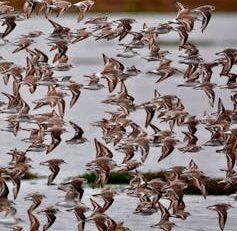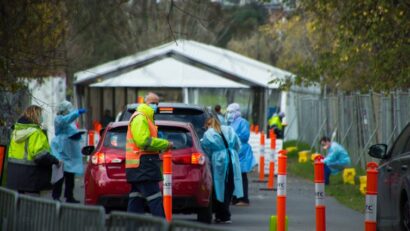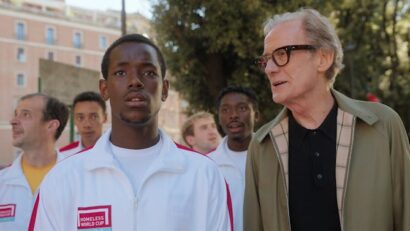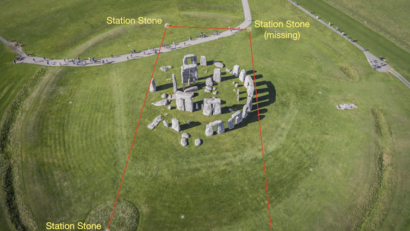
Kakapåkaka kaka
En ny klassiker kan man kalla det. Jag tog två kakor och slog ihop till en. I botten är det mördeg och ovanpå en havrekaka. Det blev en av mina favoritkakor. Lätta att göra är de också. Recept Ugnstemperatur 175 Läs mer…
Nyheter och länkar - en bra startsida helt enkelt |Oculus lyx vitae

En ny klassiker kan man kalla det. Jag tog två kakor och slog ihop till en. I botten är det mördeg och ovanpå en havrekaka. Det blev en av mina favoritkakor. Lätta att göra är de också. Recept Ugnstemperatur 175 Läs mer…

Humans love the coast. But we love it to death, so much so we’ve destroyed valuable coastal habitat – in the case of some types of habitat, most of it has gone.
Pollution, coastal development, climate change and many other human impacts have degraded or destroyed swathes of mangrove forests, saltmarshes, seagrass meadows, macroalgae (seaweed) forests and coral and shellfish reefs. We’ve lost a staggering 85% of shellfish reefs around the world and coral is bleaching globally.
When healthy, these coastal habitats help feed the world by supporting fisheries. They are home to more than 100 species of charismatic marine megafauna, ranging from sharks to dugongs. They sequester carbon, thus helping to slow climate change. The list goes on.
Restored wetlands provide vital habitat for waders like red-necked stints and curlew sandpipers, which are in sharp decline.
Michael Brown
Healthy coastal habitats are the gift that keeps on giving. We need them back, so there’s a lot of enthusiasm for restoring these habitats. For example, we can plant mangroves, build new shellfish reefs and reduce pollution to help seagrass grow back.
But we want to recover more than just the habitats. We want the animals they support too. We need to know if restoration is helping animals.
We analysed restoration projects around the world to assess how animals are benefitting. Compared to degraded sites, restored habitats have much larger and more diverse animal populations. Overall, animal numbers and the types of animals in restored habitats are similar to those in natural habitats.
So restoration works. But outcomes for animals vary from project to project. Not all projects deliver the goods. As a result, resources are wasted and humanity misses out on the huge benefits of healthy coastal habitats.
Coastal habitats are home to more than 100 large marine animals, including these rays.
Michael Sievers
Read more:
Global coral bleaching caused by global warming demands a global response
Animals can respond well to restoration
We collated over 5,000 data points from 160 studies of coastal restoration projects around the world.
Excitingly, animal populations and communities were remarkably similar to those in comparable undisturbed natural sites. For example, restoring seagrass off Adelaide’s coast brought back invertebrates, which are food for many fish species Australians love to catch, such as Australasian snapper. Invertebrate numbers here were comparable to nearby natural seagrass meadows.
Restored seagrass habitat along Adelaide’s coast supports populations of invertebrates that provide food for fish.
Read more:
From sharks in seagrass to manatees in mangroves, we’ve found large marine species in some surprising places
Overall, our review found animal populations in restored coastal habitats were 61% larger and 35% more diverse than in unrestored, degraded sites. So restoration produces serious benefits.
Some projects recorded dramatic increases. For instance, after oyster reefs were restored in Pumicestone Passage, Queensland, fish numbers increased by more than ten times. The number of fish species increased almost fourfold.
Most of the world’s shellfish reefs have been lost.
Chris Brown
And animals can occupy newly restored sites surprisingly quickly. Fish and invertebrate numbers in restored seagrass and mangroves can match those in natural sites within a year or two. This happens even though the vegetation is far sparser in restored areas.
Our study shows that efforts to restore coastal habitat certainly can help animals thrive.
Read more:
Once the fish factories and ‘kidneys’ of colder seas, Australia’s decimated shellfish reefs are coming back
Results are not guaranteed
Although restoration generally helped animals, good outcomes are not guaranteed. We found many projects where animal numbers or diversity barely increased. It was not clear why some projects were great for animals and others had lacklustre results.
The mangrove golden whistler depends on mangroves, but much of its habitat has been degraded or lost.
Michael Brown
Some restoration sites could be in places where animals cannot easily find them.
In other cases, actions to restore the habitat may simply not work. Despite our best efforts, we failed to create suitable environments.
It could be that animals are returning to restored habitats, but we’re not capturing them with our monitoring.
We sorely need more consistent restoration outcomes. We may lose community support for restoration if, for example, it doesn’t deliver on promises of improved fisheries.
We are still working out how to restore coastlines effectively. Clearly, more work is needed to improve techniques and the monitoring of animal numbers.
Global alliances and groups are developing standardised frameworks to guide restoration practice and to report on project designs and outcomes. Such strategies and co-ordination promise to deliver more consistent benefits.
The black-fronted dotterel is one of many bird species that benefit from restoring saltmarshes.
Michael Brown
Read more:
If we protect mangroves, we protect our fisheries, our towns and ourselves
New technologies can improve monitoring
Monitoring animals and restoration outcomes in coastal habitats is challenging. These aquatic habitats are structurally complex, often impenetrable and hard to navigate, and can be dangerous.
New technologies, such as artificial intelligence (AI) and environmental DNA (eDNA), allow us to collect more and better data on which animals are present and how they use these habitats. We’re rapidly becoming less reliant on hauling in nets or diving down to count animals.
Artificial intelligence (AI) can be used, for example, to extract information from underwater cameras. We can monitor animals more often, in more places, for less cost.
AI algorithms were recently used to automatically identify, size and count fish in videos taken on restored oyster reefs in Port Phillip Bay, Melbourne. These data were then used to calculate increased fish productivity due to restoration efforts. And what an increase it was – over 6,000 kilograms of fish per hectare per year!
Combining underwater videos with automated data extraction provides a new, reliable and cost-effective method for surveying animals ethically and efficiently.
Restoring shellfish reefs greatly increased fish numbers in Port Phillip Bay, Melbourne.
Read more:
It sounds like science fiction. But we can now sample water to find the DNA of every species living there
We still face major barriers to scaling up restoration to even get close to reversing our environmental impact on the coasts. Key concerns include ongoing climate change and policies and laws that hamper restoration efforts. It can be difficult, for example, to get permits to restore habitat, with complex systems involving multiple organisations and arms of government.
Still, our synthesis shows some light at the end of the tunnel. Coastal restoration efforts are having substantial benefits for animals around the world. The evidence supports ambitious restoration targets and action. Läs mer…

For many people, the term “bulk billed” refers to a GP visit they don’t have to pay for out-of-pocket. But another form of bulk billing is in the news ahead of May’s federal budget – bulk billing of pathology testing, such as blood tests.
This relates to the fees pathology companies receive from Medicare to perform out-of-hospital laboratory tests, the type your GP might order to help diagnose or monitor disease.
These pathology fees have been frozen for almost a quarter of a century. Is that fair? Obviously not, argues Australian Pathology, which represents private pathology laboratories.
It has recently launched its “Keep Pathology Bulk Billed” campaign. At the core is a request for about an extra A$160 million a year for pathology companies. It argues this is needed to keep most out-of-hospital pathology tests free for the public.
But simple solutions put forward by vested interests involving more public funds are rarely in the public interest. Here’s how we might design a fairer pathology system, fit for the 21st century, that keeps tests free for the public.
Read more:
Medicare turns 40: since 1984 our health needs have changed but the system hasn’t. 3 reforms to update it
Pathology is big business
Collecting specimens and analysing them is big business. Pathology providers received almost $3.25 billion for out-of-hospital tests in 2022-23 from Medicare rebates. Pathology testing is also conducted in public and private hospitals, but these are funded under a combination of different arrangements.
Almost all (more than 99%) of out-of-hospital pathology services are bulk billed. That’s a rate much higher than that for GP visits, which stood at about 80% in the same period.
Pathology use is increasing faster than the population is growing. That’s partly because of more chronic disease in the population, and partly because new tests are becoming available.
Pathology provision is concentrated in a few hands, with a number of providers listed on the Australian Stock Exchange. Increases in pathology rebates, as Australian Pathology is calling for, would go straight to companies’ bottom lines, increasing shareholder value.
Remember drive-through testing? In the early days of the pandemic, private pathology companies conducted millions of COVID PCR tests.
Christie Cooper/Shutterstock
So why are pathology companies calling for more funding now? Pathology companies’ profits burgeoned during the first years of the COVID pandemic, with the introduction of widespread PCR testing and the government funding that went with it.
But the industry was accused of profiting from “COVID-19 misery”, and the gravy train eventually ended. So pathology companies are now looking to replace that revenue, using the latest campaign to try to increase rebates.
Read more:
Worried about getting a blood test? 5 tips to make them easier (and still accurate)
Does the pathology industry have a point?
On the face of it, a 24-year freeze on pathology government rebates might seem unfair. But a look into the pathology world reveals an industry where there has been significant productivity growth.
An increased volume of standard tests, as we’ve seen in recent years, can lead to improved productivity. For instance, companies can work their testing equipment harder – running them for longer, loading them with more samples – lowering the cost per test. Improvements in equipment also allow tests to be done quicker, allowing increased economies of scale.
But a fee freeze is a lazy policy, an example of “set and forget”. While it does achieve some benefits for the taxpayer, it’s not optimal. That’s because it assumes all the productivity savings (from automation, digitisation and increased economies of scale) exactly offset any increased costs from inflation. This is never likely to be true. Given the current extent of automation and consolidation, this is probably leaving excess profits in the pockets of providers, and costing governments more than they need to pay.
More changes in pathology provision are yet to come. Advances in artificial intelligence are accelerating and automated reading of some pathology tests may reduce pathology costs further, yielding more profits for providers.
Future policies need to reflect changes in how much it costs to provide pathology services, details of which are thin on the ground.
Read more:
AI can help detect breast cancer. But we don’t yet know if it can improve survival rates
What needs to happen?
Government should step back and ask whether a fees-for-pathology-service payment system, designed a century ago when pathology provision was literally a cottage industry, is still right in an era of extensive automation and ownership concentration. The answer is clearly no.
Reform should first dump the existing uncapped, fee-for-service payment system. Pathology is a big business and should be paid as such using tenders and contracts.
Pathology providers should be invited to tender for contracts, to keep costs down.
fizkes/Shutterstock
Pathology companies should be invited to tender to provide out-of-hospital pathology services in designated geographic areas. Two or more tenders could be approved to maintain competition between providers and keep options open for the end of the tender period. Pathology contracts should involve no out-of-pocket payments by consumers.
In-hospital pathology should not be covered by the same arrangements. Instead, private hospitals should make their own contractual arrangements for pathology provision, as they do now.
Public pathology services – run by state governments or their agencies such as Pathology Queensland – are also changing.
Consolidation of public pathology services in New South Wales yielded significant improvements in productivity. Victoria has started a less ambitious reform process, consolidating into three public providers rather than the single public provider model seen in NSW, Queensland and South Australia. This will also probably yield savings.
Public providers should be invited with private providers into the tender process to enhance competition.
What’s the take-home message?
The world of pathology provision is in flux, with more changes on the horizon, whether that’s related to technology or consolidation. In this environment, paying more to private providers under a payment system that has passed its use-by date is not good policy. That’s despite its simplistic attraction and advocacy from vested interests.
So the next time you go to a pathology collection centre and see posters encouraging you to email your MP to “keep pathology bulk billed”, beware. The campaign is more about company profits than saving you money. Läs mer…

Israel has carried out a missile strike on Iran in retaliation for a recent barrage of missiles and drones launched by the Iranians towards Israeli soil.
Notably, Israel’s strike against Iran appears to have been more symbolic than substantive. Nevertheless, the overnight Israeli strike is the latest escalation in tensions between the two countries.
The hostilities boiled over after Israel’s April 1 attack on Iran’s embassy in Damascus, which killed a senior Iranian military leader. Israel, in eliminating a key figure in the Quds Force, sought to undermine Iran’s influence with its proxy forces in the region, most notably Hezbollah and the Houthi.
Read more:
Western strikes against Houthis risk igniting a powderkeg in the Middle East
Reputations at stake
Iran soon retaliated. To do otherwise would have damaged the Iranian government’s reputation among both its allies and its citizens.
But the form that Iranian retaliation took is a key indication of Iran’s intentions. Its choice to mostly use slow-moving drones and cruise missiles, even though on a large scale, is demonstrative of its own relative weakness.
The Israeli Iron Dome air defence system launches to intercept missiles fired from Iran in central Israel on April 14, 2024, after Iran launched its first direct military attack against Israel.
(AP Photo/Tomer Neuberg)
Israel’s Iron Dome missile defence system and U.S. military bases in the region made the likely impact of Iran’s attack minimal.
Iran, in choosing a means to strike Israel that was easily countered, seemingly sought to symbolically strike back at the Israelis by providing an avenue for the cycle of violence to end by not inflicting significant damage. This effort, however, ignores the domestic situation within Israel that ultimately fuelled the country’s decision to strike targets in Iran in the early morning of April 19.
The proxy dilemma
Since the Iranian Revolution, Iran, through the Quds Force and its predecessors, has actively courted several proxy groups in the Middle East to increase its strategic influence. Most prominent among these groups is Hezbollah, a militant group turned political party based out of Lebanon.
Hezbollah came into existence in response to Israel’s invasion of southern Lebanon in the 1980s, and received extensive support from Iran. Hezbollah has been a thorn in Israel’s side ever since, engaging in small-scale skirmishes along the border with Israel since the Hamas attacks on Israelis on Oct. 7, 2023.
While these proxy groups have increased Iran’s political influence and strategic options in the Middle East, they can simultaneously be a burden for the country’s leadership because they aren’t under Iran’s complete control. Furthermore, they can also create pressure on Iran’s leadership to radicalize their stances to avoid losing influence over these groups.
For Iran, this presents a strategic dilemma. Much Iranian influence and prestige among its proxy groups is based on being seen as opposing Israel and the U.S. and leading the so-called Axis of Resistance, a group of state and non-state entities centred in Iran that oppose Israel and the American presence in the region.
Read more:
What is Iran’s ’axis of resistance’ and why is it uniting in fury against the US and Israel?
Iran, therefore, has tried to thread the needle by appearing to support its proxies and oppose Israel and the U.S. while simultaneously seeking to limit the damage that any provocations would cause Iran’s interests.
Iran’s drone and missile strikes were designed to give Israel an off-ramp. This off-ramp, however, only works if one disregards Israel’s domestic politics.
A woman walks past a banner showing missiles being launched in northern Tehran on April 19, 2024 following Israeli drone strikes on Iran. A decorative sign reads ‘Allah’ on the missiles.
(AP Photo/Vahid Salemi)
A coalition of many
Israel’s government was in a tenuous position before the war in Gaza.
The 2022 elections returned a fractured Knesset, and Prime Minister Benjamin Netanyahu was only able to form a coalition government that included several far-right parties. The small size of his majority meant that far-right partners were able to demand concessions to support his government.
The Oct. 7 attacks initially unified Israeli society behind the government. The way Israel has conducted the war, however, has caused this support to decline in some circles. The government’s inability to negotiate a release for the remaining hostages held by Hamas remains a festering wound in Israeli politics.
Ironically, the decision of Israel’s political establishment to rally around the state exasperated these problems. National Unity, the chief opposition party, supported the government. National Unity’s leader, Benny Gantz, formed a war cabinet with Netanyahu and Israeli Defence Minister Yoav Gallant to direct the war effort.
Israeli Prime Minister Benjamin Netanyahu, Defense Minister Yoav Galant and cabinet minister Benny Gantz speak during a news conference in Tel Aviv in October 2023, two weeks after the Hamas attacks.
(Abir Sultan/Pool Photo via AP)
Gantz has emerged as a voice of moderation in Israel’s response to Iran. As a former chief of general staff of the Israel Defense Forces from 2011 to 2015, Gantz knows better than most people in government the many strategic problems Israel faces if tensions spin out of control.
While acknowledging that Israel would retaliate for Iran’s missile and drone attacks, he stated Israel would do so “in the place, time and manner it chooses.” Gantz, by creating ambiguity in Israel’s response, actually worked to de-escalate the tension.
Netanyahu’s hand forced?
The smaller far-right parties in Netanyahu’s coalition that are outside the war cabinet, however, likely forced the prime minister’s hand.
National Security Minister Itamar Ben-Gvir, leader of the ultra-nationalist Otzma Yehudit party, has stated that Israel needs to “go crazy” in its response.
Israeli Finance Minister Bezalel Smotrich speaks at the Knesset, Israel’s parliament, in Jerusalem, in July 2023.
(AP Photo/Maya Alleruzzo)
Finance Minister Bezalel Smotrich stated that if Israel’s response “resonates throughout the Middle East for generations to come — we will win.”
Netanyahu, with a tenuous domestic position and needing the support of his far-right allies, likely felt he had to act.
What’s next?
From a strictly military standpoint, Israel has achieved a victory in its exchanges with Iran. It eliminated a leader of the Quds Force, and Iran’s retaliation did not manage to breach the defences of Israel or its allies. War, however, is said to be the continuation of politics by other means.
In this case, Israel’s domestic politics trumped otherwise rational strategic calculations. Iran previously stated on several occasions that Israeli retaliation would be responded to in kind.
Now, the world waits to see if Israel’s latest strike against Iran leads to a broader regional escalation. Läs mer…

The Beautiful Game is a film of second chances — where teams of homeless men and women from around the world find that all roads lead to Rome and everything’s to play for.
Starring Bill Nighy as coach Mal, it follows the England team as they prepare for the Homelessness World Cup in Rome. At the last minute, Mal decides to bring with them a talented striker Vinny (Michael Ward), who could give them a chance at winning, but only if he’s ready to let go of his past and become part of the team.
The Homelessness World Cup is a real football tournament and the film was made by the foundation responsible for the annual games.
The idea for Homeless World Cup (HWC) Foundation emerged in 2001. It was created by The Big Issue, a magazine that supports homelessness, co-founder Mel Young and Austrian journalist Harald Schmied with the aim of transforming lives, creating opportunities and changing perceptions of homelessness.
To date, HWC has helped 1.2 million homeless people through a network of more than 70 grassroots organisations in more than 70 countries. The Cities Ending Homelessness Report supported by HWC notes that along with interventions around housing, mental health and employment, HWC football is helping to change the narrative from managing the homeless problem to ending homelessness.
As someone who has worked with people who have been helped by the tournament, I found the film captured the spirit, commitment and, in part, the remarkable story of the Homelessness World Cup.
A sense of hope and purpose
Last year’s tournament involved 400 players representing 40 countries and took place in Sacramento, California in the US. The teams competed in a week-long football tournament for seven prizes: four for the men’s competition and three for the women’s. The tournament marked 20 years of HWC and was won by Mexico’s women’s team and Chile’s men.
An HWC survey found that 94% of players say the foundation has had a positive effect on their lives, 83% improved their relationship with families and friends and 77% say that HWC has changed their lives significantly and 76% continue to enjoy and play the sport.
Many of the extras in the film had been helped by HWC. Bill Nighy told the BBCthat the best bit about being in the film was meeting the extras who had participated in the real tournaments and are now no longer homeless.
As a sports academic, I have worked with HWC and spoken to many people who they have helped. In a journal article, my colleague Susan Ahrens and I sought to find out to what extent football could increase the capability of the homeless and those living on the street. We did so by focusing on how the Homeless World Cup and Street Soccer (Scotland) have affected the lives of some people.
During this research, I spoke to people whose lives had been changed by competing. The stories I heard were about finding hope in sport. As one man told me: “It helped me mentally because I was starting to get depressed but the football and goal of HWC helped me feel more positive.”
Others spoke of gaining purpose and control. “I want to feel like I have control in an aspect of my life again … At the moment soccer gives me this.”
Many also said that the experience had given them hope for the future. “To me it [HWC] was a symbol of hope, determination, strength, and courage. It was the first time in my life I was proud to say I was an addict in recovery.”
Our research found that interventions that start small can make a big difference. Football can contribute to non-football outcomes, such as reducing homelessness and building other skills such as team work and communication.
Vinny is unwilling, at first, to be a team player because he doesn’t see himself as homeless. However, he grows and learns to accept his circumstances with the help of Mal and his teammates.
Netflix
The Beautiful Game echoes our research as it celebrates the power and potential of team sports for those who might feel pushed to the margins. We watch as Vinny refuses to relate to his team mates and to accept his homelessness. Playing as part of a team helps him to open up and be hopeful. Winning is not the real reward of playing in the HWC, it’s the interpersonal skills Vinny learns and the personal development he experiences.
The film is a testament to the reach and capability of football as a tool to make a difference that goes beyond the pitch.
Looking for something good? Cut through the noise with a carefully curated selection of the latest releases, live events and exhibitions, straight to your inbox every fortnight, on Fridays. Sign up here. Läs mer…

Some years ago, I found myself making my way up the narrow stairs of a Learjet on a sultry runway in a deserted airport near the South Africa-Mozambique border. The humidity was there to taste – the air thick with it.
The weather radar was showing a fast-developing thundercloud. Our mission was to fly through the most active part of the storm, measure it, fly through again while dumping a bin load of dry ice, turn hard and fly through for a final measurement.
The inside of the Learjet resembled a food blender, so severe was the turbulence. Thousands of meters below, a smaller plane would be threading through the storm downdrafts measuring the rain. It isn’t something you do every day although the saucer-sized hail dents on the wings of the Learjet told of its many prior engagements.
Apart from the fun of flying through the core of a thunderstorm in a Learjet, I didn’t think much about the time I was lucky enough to be part of that project. Until I heard about the recent freak storm in Dubai.
The project I was part of, neatly named Rain (Rain Augmentation in Nelspruit), was a cloud seeding experiment several years in the making. Cloud seeding involves adding tiny particles into a cloud in order to give moisture something to attach to and form droplets. Gradually those droplets merge and become heavy enough to fall as rain. In theory, the “seeeded” clouds will grow more droplets suitable for rain.
No one flight is proof of seeding having been effective. It can’t be. There is no identical cloud with which to compare the outcome of having seeded a particular cloud. It is therefore necessary to fly a lot of missions and to measure, but not seed, half of them thereby creating a data set for the experiment itself (seeded clouds) and the control (unseeded clouds).
Statistical analysis of the results from Rain was rigorous to say the least. After several years of trying, modification of rain rates from some storms was successful, although it would never be possible to prove that any one storm had been changed.
A perfect storm
Early on Tuesday morning, April 16, the chat network of my school class which is replete with global insights after 40 years of dispersion, lit up with reports of unprecedented rain from Brendan in Bahrain and Ant in Dubai. Ant is a pilot and was flying out of Dubai that morning. He duly relayed photographs of his flight over the saturated desert.
Clouds above Saudi Arabia’s ‘Empty Quarter’ desert, April 16. The big vertical cloud is a cumulonimbus (thundercloud) near the edge of the major storm cluster which is far larger. The outflow from the main storm is the dark stuff at the very top of the photo.
Ant McHale
Parts of the Arabian Peninsula received 18 months of rainfall in 24 hours that Tuesday. The airport looked more like a harbour. Being the weather-man in the chat group, I looked at the satellite and the forecast model data. What I saw were the ingredients of a perfect storm.
What normally keeps the old deserts, such as those of the Arabian Peninsula, so very dry is persistent and intense sinking of air – the very opposite of what is required for rain. The sinking air is bone dry, having come from the cold, top of the atmosphere, and is compressed and warmed as it descends. It arrives near the surface like a hairdryer.
Below this layer, especially in deserts close to warm oceans, evaporation is plentiful. But that humidity is kept captive by the sinking air above. It is a cauldron with the lid firmly on.
What took that lid off the cauldron on 16 April was a high-altitude jet stream unusually far south. In fact two jet streams, the subtropical jet and the polar jet that had joined forces and left behind a cut-off circulation of imported, cooler air. The sinking air, along with the cauldron lid, was gone.
Meanwhile a feed of moisture laden air was accelerating in from the northern tropical Indian Ocean and converging over the desert. Dew point temperatures over the UAE were similar to those normally found in the rainforests of the Congo basin.
Under these conditions, thunderstorms develop very readily and in this case a special kind of storm, a mesoscale convective system, built and sustained itself for many hours. Infrared satellite data showed it to be about the size of France.
Cloud seeding not to blame
The power, intensity and organisation of a storm like this is hard to fathom. What surprised me, though, was not the majesty of nature, but an emerging set of reports blaming the ensuing rains on cloud seeding. One broadsheet even insinuated the University of Reading, a powerhouse of meteorological expertise, was responsible.
It turns out the UAE has been running a cloud seeding project, UAE Research Program for Rain Enhancement Science, for several years. Their approach is to fire hygroscopic (water-attracting) salt flares from aircraft into warm cumuliform clouds. The idea, similar to the Rain project I once worked on, is to promote the growth of cloud droplets and thereby rainfall. Bigger droplets fall out more easily.
So could seeding have built a huge storm system the size of France? Let’s be clear, that would be like a breeze stopping an intercity train going at full tilt. And the seeding flights had not happened that day either. The kind of deep, large-scale clouds formed on April 16 are not the target of the experiment.
The interesting thing is that humans have a hard time coming to terms with the fact that 2,400 gigatonnes of carbon (our total emissions since pre-industrial times) might make a difference to climate, but very readily get behind the idea of a few hygroscopic flares making 18 months worth of rain fall in a day. Läs mer…

Every spring and summer, when the weather improves, the numbers of people trying to cross the Mediterranean to Europe drastically increase, sometimes tripling. Distressing photos and headlines dominate front pages, and politicians stoke negative narratives about migration.
People migrate for many reasons: safety, work, education, family or adventure. Even though politicians like to divide migrants into neat categories, such as refugees and economic migrants, the messy reality is that most people moving fit into several categories at once. This makes it all the harder for governments to stop it from happening, try as they might.
Some adopt a “send ‘em back” approach, like the UK’s proposed Rwanda policy. Also popular is the “cash for migration control” approach, turning countries on the edges of Europe into, effectively, “border guards”. One example is the EU’s recent deal with Tunisia, promising €150 million (£128 million) to boost Tunisia’s migration control efforts.
A refrain often heard is that the best way to address migration is to “tackle the root causes” – improve people’s lives in their countries of origin so that they are less likely to need or want to migrate in the first place. This approach proposes giving aid money to poorer countries to, for example, help create local jobs and improve schools and healthcare.
This approach seems to make sense, and feels more humane and certainly less unpleasant than implementing a Rwanda-style deportation plan. But there is not much consensus on what the root causes of migration actually are, and little evidence to show that addressing them actually reduces migration.
In MIGNEX, an EU-funded research project on global migration, I worked with a team of researchers to look at what drives people to consider leaving their families and communities and move to another country. We looked at 26 communities across ten countries in Africa, Asia and the Middle East, using data from more than 13,000 interviews.
Tackling the root causes
People living in poorer countries experience many social and economic challenges. These are often discussed as “root causes” – which MIGNEX defines as widely experienced hardships that are perceived to be persistent, immediately threatening or both, and to which migration is a possible response.
But which ones are the most important drivers for people to take the enormous step of leaving home for somewhere new?
The problem in migration policymaking – which often relies on intuition and guesswork, rather than evidence – is a scatter-gun approach which lists a whole range of issues as root causes. A case in point is the European Trust Fund for Africa which funds development projects to promote resilience, economic and equal opportunities, security and development, and end human rights abuses.
Policymakers assume that addressing all of these issues will reduce people’s desire to migrate. But often, these assumptions do not hold. Through our research, we have found that reducing poverty and raising educational levels might actually increase desires to migrate, because it gives people the means to do so and broadens their horizons. For example, having a PhD increases migration aspirations by 22%, compared to those with no formal education.
Addressing other drivers – such as scarce livelihoods and a lack of good jobs – might be more effective, but even so it tends to take generations before international migration is no longer desirable. Creating jobs also tends to be incredibly costly, for example the World Bank estimates that an investment of the equivalent of £8 million in Tunisia would create, at most, 300 jobs in the trade and construction sectors, at the cost of £24,000 per job.
Women looking at a job board in Kombolcha, Ethiopia.
Camille Kasavan for MIGNEX, Author provided (no reuse)
Instead, what we have found is that addressing corruption is key to reducing people’s aspirations to migrate. People living in communities where being asked to pay a bribe for a service is a common practice are 36% more likely to have strong wishes to migrate.
Corruption is not merely a nuisance but typically a symptom of deeper and less obvious societal challenges. Corruption in hospitals, schools and police forces can be signs of low pay, inadequate management and a lack of accountability.
For example, in Redeyef, a declining mining town in Tunisia’s desert, high levels of corruption block many qualified young people from the most desirable jobs, contributing to an overwhelming sense of hopelessness. Tackling corruption, therefore, can improve lives and strengthen people’s confidence to build their futures locally, rather than seeking opportunities elsewhere.
Aid and migration control
None of this evidence makes richer countries’ efforts to help poorer countries reduce poverty, create jobs and expand education any less necessary. These policies continue to be important in their own right, and often make a significant difference to improving people’s lives and wellbeing.
Tackling the root causes of migration is not an easy, short-term fix to prevent migration. Governments allocating aid must separate this from the issue of migration, so that this money can be channelled into what it’s actually meant for: addressing economic, humanitarian, political and security issues.
Meanwhile, any policy responses to manage migration must be tailored to the specific local context – people’s concerns and motivations to migrate are different everywhere. Läs mer…

Hateful graffiti and other imagery plague communities across the UK, spreading a toxic message of division. Such graffiti targets people based on race, religion, sexual orientation, disability and gender identity.
And sprayed graffiti is only one part of the problem. Hateful imagery can range from stickers and QR codes to leaflets, posters and engravings. These types of symbols and text can be used by organised extremist groups for coded communication, recruitment and to highlight their presence in an area.
Unfortunately, there is no comprehensive system for recording these types of images in the UK, so it’s difficult for researchers to understand the extent of the problem. This is why we’ve developed an app called StreetSnap to record instances of hateful graffiti and other visuals.
Hateful graffiti counts as a hate crime. Recent government figures show a 5% drop in hate crime. But since the start of the conflict in Israel and Gaza in October 2023, police have recorded a rise in religious hate crimes.
In November 2023, two London schools reported incidents of Islamophobic and antisemitic graffiti. The Weiner Holocaust Library and several other locations around London have been targeted by a spate of far-right racist graffiti.
Transphobic graffiti plagued various sites across Tyneside in 2023. While more than a third of graffiti in Edinburgh over the past five years was revealed to be racist or offensive.
More recently, following amendments to hate crime laws in Scotland, Scottish first minister Humza Yousaf became the target of Islamophobic and racist graffiti outside his home in Dundee.
Under-reporting
But while we have sporadic reports of such incidents in the news, the under-reporting of hate crime and issues with police data collection in some parts of the UK prevent us from seeing an accurate picture. The situation is compounded by an under-reporting of anti-social behaviour.
In recent years, there has been a drive to tackle different types of hate crimes through various government action plans and a parliamentary anti-hate crime group, which was launched in 2018.
The social, cultural and economic landscape is changing in the UK. Issues such as war, immigration, people seeking asylum and the rising costs of living are changing and challenging communities. As a result, it is now more important than ever that hateful graffiti and symbols are better understood. They need to be comprehensively identified, reported, removed and used for analysis by academics.
Unfortunately, general research on this topic is sparse. But one Australian study showed that hateful graffiti can heighten people’s perceptions of insecurity and fear of crime.
We also know that the fear of hate crime and antisocial behaviour in general influence the way people use places and interact with one another. For example, parents may become reluctant to let children play in certain parks, while women and girls may avoid walking in certain areas after dark.
The famous Penny Lane in Liverpool was targeted with racist graffiti in 2020.
IAN Fairbrother/Alamy
Hateful graffiti, whether fuelled by malicious intent or simply ignorance, may have the same destructive effect on individuals, groups and communities. It could contribute to a climate where expressions of hate are considered commonplace, solely a part of the environment in which we live. This may lead to a troubling trend: the normalisation of hate.
Tolerance of hateful graffiti, and lack of action, can therefore suggest a message of silent acceptance, and implicit agreement within an area. This may help to imply who is welcome or belongs in an area, and those who do not because they are “different”. This could affect community cohesion and may cause local tensions.
Councils across the UK vary in their approaches to visual hate like graffiti but it is difficult to pin down any specific mandates regarding its removal. In 2014, the UK government’s then communities secretary, Eric Pickles, wrote to local authorities to draw attention to the effect of hateful graffiti on people and communities. The letter highlighted the importance of reporting and photographing instances before removal. But this is still being overlooked by councils, as we have discovered.
StreetSnap
Our app lets selected users like the police, councils, housing association staff and youth workers photograph hateful imagery and upload the pictures to a shared system.
Our intention is that this will allow for easier communication between various authorities, as well as identification and removal by councils. More importantly, though, the data gathered can be used to identify and understand patterns and help monitor community tensions.
An example of Nazi graffiti which was identified and photographed by a member of the StreetSnap team.
StreetSnap, Author provided (no reuse)
It is currently being piloted by Bridgend County Borough Council in south Wales. Although it is still early days, the data being gathered is already helping the local authority to identify and remove hateful graffiti and other imagery.
We aim to refine the app so that it can be rolled out to other councils across the UK. This will hopefully lead to better data being gathered and studied in future. Läs mer…

George Gershwin’s 1924 composition Rhapsody in Blue is so timeless that it seems scarcely possible that he composed it 100 years ago. Its centenary offers us a special opportunity to celebrate this iconic work that defies time and place.
As the director of University of Plymouth’s Musica Viva concert series, I organised a special celebration concert on January 27, featuring the London Gershwin Players conducted by the wonderful Mark Forkgen. It was an all-Gershwin programme that also included the overture to the musical Girl Crazy, A Porgy and Bess Fantasy and An American in Paris.
But rather than performing the most frequently heard 1942 symphonic orchestration of Rhapsody in Blue, we performed the original Paul Whiteman Band version – the incisive, dynamic and wonderfully playful and jazzier orchestration of Gershwin’s 1924 original.
Setting the stage
Gershwin (1898-1937) first composed hit songs for Broadway musical theatre. Uniquely, he blended jazz and classical elements in varying degrees in his longer compositions. He had a highly original melodic gift, and his many songs and other compositions brought joy and optimism to his audiences.
Gershwin’s musical education started with exposure to classical and popular compositions he heard at school in New York. His parents, Russian Jewish immigrants, bought a second-hand upright piano when he was 11. In his early teens, Gershwin broadened his musical education by studying composition with leading members of the American musical community, including composers and pianists Henry Cowell and Wallingford Riegger.
After leaving school at 15, Gershwin earned an income by playing in New York nightclubs. He also demonstrated sheet music by playing it live for the Remick music publishing company; this introduced him to a wide range of popular songs and jazz.
Gershwin’s first published song (1916) was When You Want ’Em You Can’t Get ’Em (When You’ve Got ’Em You Don’t Want ’Em). Three years later, entertainer Al Jolson performed the Gershwin song Swanee in the musical Sinbad, which became an enormous success.
In the early 1920s, Gershwin wrote songs for various Broadway shows and revues, including (I’ll Build a) Stairway to Paradise and Somebody Loves Me. His older brother Ira was the lyricist for almost all these songs. Ira’s witty lyrics, often punctuated with wordplay and puns, received almost as much acclaim as George’s compositions and were fundamental to their success.
Melding classical music with jazz
Throughout his career, Gershwin also focused on orchestral compositions, often melding musical styles in ways that brought special freshness and enduring grace to his works. His larger works involving orchestra include the opera Porgy and Bess, Rhapsody in Blue, a Piano Concerto, Cuban Overture and Second Rhapsody.
Gershwin was gregarious, with a genuinely magnetic personality and was always eager to learn from others. He loved his work and approached every assignment with enthusiasm, never suffering from composer’s block.
He was interested in many styles of music and composition and requested lessons from Ravel and even Schoenberg, both of whom declined to teach him as they did not want to interfere or influence his unique personal voice and style. (However, Gershwin and Schoenberg did engage in weekly games of tennis.)
Paul Whiteman, a popular bandleader who had conducted the pit orchestra for the popular musical Scandals (1922), was impressed by Gershwin’s songs in that work. He and Gershwin shared the notion of integrating elements of jazz and classical styles, and in late 1923, Whiteman asked Gershwin to compose a work for a concert he was planning called An Experiment in Modern Music, which was to take place at New York’s Aeolian Concert Hall, a classical venue.
A poster announces Gershwin’s new composition in 1924.
gershwin.com
Apparently, Gershwin forgot about the request until early January 1924 when his brother Ira saw a newspaper article announcing George’s new work in the upcoming concert. Gershwin got to work shortly after, composing Rhapsody in Blue in just three weeks, an astonishing feat given its musical complexity. This initial version was orchestrated by Ferde Grofé specifically for Paul Whiteman’s band. It is this original version that we performed recently in the Musica Viva series.
Gershwin incorporated into the Rhapsody hallmarks of jazz including expressive blue notes (flatted, or lowered, notes) long passages of syncopated rhythms, and onomatopoeic musical effects. He subsequently reflected:
There had been so much chatter about the limitations of jazz, not to speak of the manifest misunderstandings of its function. Jazz, they said, had to be in strict time. It had to cling to dance rhythms. I resolved, if possible, to kill that misconception with one sturdy blow … No set plan was in my mind, no structure to which my music would conform. The Rhapsody, you see, began as a purpose, not a plan.
The premiere performance, with Gershwin playing the solo piano part, was attended by musical luminaries including Igor Stravinsky, Fritz Kreisler and Leopold Stokowski. Rhapsody in Blue was an immediate public success and brought Gershwin worldwide acclaim.
Owing to its popularity, Grofé subsequently made an arrangement for a large orchestra in 1942 which has become the more frequently performed version. I have played this later version many times with various orchestras, but have long wanted to perform the original 1924 version for the 23-member Whiteman band. I believe it is tighter, edgier, more incisive and yet more intimate, embodying Gershwin’s idea of combining classical and jazz musical elements.
So beloved was Gershwin throughout not only America but also across Europe, that when he died at 38 of a brain tumour, the novelist John O’Hara summed up popular sentiment: “George Gershwin died on July 11, 1937, but I don’t have to believe it if I don’t want to.” Läs mer…

When it comes to its connection to the sky, Stonehenge is best known for its solar alignments. Every midsummer’s night tens of thousands of people gather at Stonehenge to celebrate and witness the rising Sun in alignment with the Heel stone standing outside of the circle. Six months later a smaller crowd congregates around the Heel stone to witness the midwinter Sun setting within the stone circle.
But a hypothesis has been around for 60 years that part of Stonehenge also aligns with moonrise and moonset at what is called a major lunar standstill. Although a correlation between the layout of certain stones and the major lunar standstill has been known about for several decades, no one has systematically observed and recorded the phenomenon at Stonehenge.
This is what we are aiming to do in a project bringing together archaeologists, astronomers and photographers from English Heritage, Oxford, Leicester and Bournemouth universities as well as the Royal Astronomical Society.
There is now an abundance of archaeological evidence that indicates the solar alignment was part of the architectural design of Stonehenge. Around 2500 BC, the people who put up the large stones and dug an avenue into the chalk seemed to want to cement the solstice axis into the architecture of Stonehenge.
Archaeological evidence from nearby Durrington Walls, the place where scientists believe the ancient people who visited Stonehenge stayed, indicates that of the two solstices it was the midwinter one that drew the largest crowd.
But Stonehenge includes other elements, such as 56 pits arranged in a circle, an earthwork bank and ditch, and other smaller features such as the four station stones. These are four sarsen stones, a form of silicified sandstone common in Wiltshire, that were carefully placed to form an almost exact rectangle encompassing the stone circle.
Only two of these stones are still there, and they pale in comparison to their larger counterparts as they are only a few feet high. So what could their purpose be?
Only two of the station stones are still there.
Drone Explorer/Shutterstock
Lunar standstill
The rectangle that they form is not just any rectangle. The shorter sides are parallel to the main axis of the stone circle and this may be a clue as to their purpose. The longer sides of the rectangle skirt the outside of the stone circle.
It is these longer sides that are thought to align with the major lunar standstill. If you marked the position of moonrise (or set) over the course of a month you would see that it moves between two points on the horizon. These southern and northern limits of moonrise (or set) change on a cycle of 18.6 years between a minimum and a maximum range – the so-called minor and major lunar standstills, respectively.
The major lunar standstill is a period of about one and a half to two years when the northernmost and southernmost moonrises (or sets) are furthest apart. When this happens the Moon rises (and sets) outside the range of sunrises and sets, which may have imbued this celestial phenomenon with meaning and significance.
The range of Moonrise positions on the horizon during minor and major lunar standstills.
Fabio Silva, CC BY-NC
The strongest evidence we have for people marking the major lunar standstill comes from the US southwest. The Great House of Chimney Rock, a multi-level complex built by the ancestral Pueblo people in the San Juan National Forest, Colorado, more than 1,000 years ago.
It lies on a ridge that ends at a natural formation of twin rock pillars – an area that has cultural significance to more than 26 native American tribal nations. From the vantage point of the Great House, the Sun will never rise in the gap between the pillars.
However, during a major standstill the Moon does rise between them in awe-inspiring fashion. Excavations unearthed preserved wood that meant researchers could date to the year episodes of construction of the Great House.
Of six cutting dates, four correspond to major lunar standstill years between the years AD1018 and AD1093, indicating that the site was renewed, maintained or expanded on consecutive major standstills.
Returning to southern England, archaeologists think there is a connection between the major lunar standstill and the earliest construction phase of Stonehenge (3000-2500 BC), before the sarsen stones were brought in.
Several sets of cremated human remains from this phase of construction were found in the southeastern part of the monument in the general direction of the southernmost major standstill moonrise, where three timber posts were also set into the bank. It is possible that there was an early connection between the site of Stonehenge and the Moon, which was later emphasised when the station stone rectangle was built.
The major lunar standstill hypothesis, however, raises more questions than it answers. We don’t know if the lunar alignments of the station stones were symbolic or whether people were meant to observe the Moon through them. Neither do we know which phases of the Moon would be more dramatic to witness.
A search for answers
In our upcoming work, we will be trying to answer the questions the major lunar standstill hypothesis raises. It’s unclear whether the Moon would have been strong enough to cast shadows and how they would have interacted with the other stones. We will also need to check whether the alignments can still be seen today or if they are blocked by woods, traffic and other features.
The Moon will align with the station stone rectangle twice a month from
about February 2024 to November 2025, giving us plenty of opportunities
to observe this phenomenon in different seasons and phases of the Moon.
To bring our research to life, English Heritage will livestream the southernmost Moonrise in June 2024, and host a series of events throughout the year, including talks, a pop-up planetarium, stargazing and storytelling sessions.
Across the Atlantic, our partners at the US Forest Service are developing educational materials about the major lunar standstill at Chimney Rock National Monument. This collaboration will result in events showcasing and debating the lunar alignments at both Stonehenge and at Chimney Rock. Läs mer…

The world’s oldest conjoined twins, Lori and George Schappell, recently died, aged 62.
Doctors predicted that the twins (who were joined at the skull and shared 30% of their brain) would not live past the age of 30. But the twins defied expectations and managed to live long and successful lives.
The twins made headlines in 2007 when George came out as transgender.
Conjoined twins are incredibly rare, accounting for about one or two in every 100,000 births. Sadly, about 60% of conjoined twin births are stillborn or die shortly after birth. Conjoined female twins are three times more likely to survive than males.
Although all conjoined twins are identical (monozygotic), recent genetic analyses have revealed that there are differences in genes, including those linked to growth and development.
Because conjoined twins are so rare, it is difficult to know exactly how they come about. However, there are two possible causes, both of which have some evidence to support them, but neither can completely account for the full range of presentations that are seen.
The first process is “fission”, where a single fertilised egg does not fully split during the process of forming identical twins. The second process is “fusion”, where two fertilised eggs fuse soon after fertilisation occurs.
Types of conjoined twins
There are 15 recognised types of conjoined twins, based on the various places their bodies fuse.
The most common fusion site is the chest and abdomen (thoraco-omphalopagus). Other common fusion sites are the chest (thoracopagus), the abdomen (omphalopagus) and the skull (craniopagus).
The first part of the word is the body part that is fused, and “pagus” is Greek for “fixed”. They can also be described by number (bi, tri or tetra for two, three or four), so a “dicephalic parapagus” conjoined twin would have one trunk and two heads.
Conjoined twins are usually picked up on routine ultrasound scans performed during pregnancy. This would then be followed up by MRI scans to get a clearer picture of the type of fusion as well as information on which organs are shared. This helps healthcare professionals to manage any complications that occur during delivery and provides useful information on potential surgical separation further down the line. Sadly, it also provides information on whether a termination is necessary.
Conjoined twins who are diagnosed by imaging are typically delivered by caesarean section.
George enjoyed a successful career as a country singer while Lori was a trophy-winning ten-pin bowler.
Associated Press/Alamy Stock Photo
Separating twins
Surgery to separate conjoined twins is highly complex and only a few hospitals and surgical teams have performed them; they include Great Ormond Street Hospital in London, Children’s Hospital of Philadelphia and Red Cross Children’s Hospital in Cape Town. Surgeons in Saudi Arabia are also renowned for performing these surgeries, with the surgeon to the Royal Court performing at least 60.
As medical advances continue, more hospitals are beginning to undertake these operations, which can last more than 24 hours. One of the longest operations to separate conjoined twins, who were fused at the cranium, took more than 100 hours.
The earliest recorded attempt at surgical separation of conjoined twins dates back to AD945 in Armenia where conjoined brothers lived until middle age before one of them died. Surgeons tried to separate the living brother from his deceased sibling, but he died a couple of days later.
The first successful surgical separation of conjoined twins was undertaken in 1689. These were xiphophagus twins, meaning they were fused by the bottom of their sternums. In slightly more recent history (1860), a surgeon separated his own omphalopagus daughters. Unfortunately, only one survived.
Those fused at the abdomen (omphalopagus) have the best chance of surviving separation surgery. There are more than 100 documented cases of both separated twins surviving.
Separating conjoined twins requires a significant amount of planning before surgery can begin, including, of course, lots of imaging such as ultrasound, CT and MRI.
Although this imaging will tell doctors whether each twin has their own set of organs – and which, if any, are connected – it doesn’t tell them whether each can function fully to support the respective twin in an independent life.
This is where further imaging assessments are needed using technology such as fMRI, contrast-enhanced CT, diffusion tensor imaging and vascular imaging to determine if systems such as the liver, gut and urinary systems of each twin have their own blood supply to ensure they can function after they are separated.
While surgery commences as a single operation, as it progresses it becomes two separate surgeries once the twins are separated, which requires two teams of surgeons, anaesthetists and theatre staff to deal with each child.
Twins who share vital organs – or whose organs are fused – have a lower chance of a successful separation.
Krista and Tatiana Hogan, Canadian conjoined twins share a thalamus (an egg-shaped structure in the middle of the brain), which raises questions about whether their experiences can be felt by the other, even though they are separate people.
The process of separation of conjoined twins raises ethical questions about potential harm or even death of one twin to benefit the other, and this is often a significant issue in any potential surgical intervention. Läs mer…